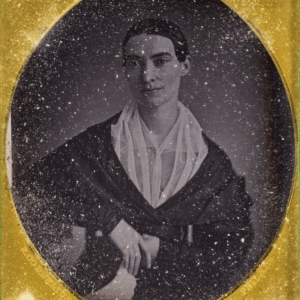JTF (just the facts): Published in 2023 by Bad News Books (here); co-published by PhotoForum (here). Linen hardcover with tipped-in black-and-white photograph, 202 × 250 mm, 100 pages, with 58 duotone plates. Includes texts, notes, and lists by the artist. In an edition of 500 copies. Design by Sam Fraser and the artist. (Cover and spread shots below.)
Comments/Context: It’s not all that common for a photographer to proactively categorize his or her own work as part of a particular artistic style or movement. More often, photographers are more coy, wanting to intentionally avoid such labeling, trying to stay outside definitional lines that would limit or define their creativity too narrowly. But in the explanatory preamble to his photobook Mirror City, Harry Culy roots his photographs in the style of the “Antipodean Gothic”. For many viewers, defining such a term might be a bit difficult, but if we carefully parse its words – Antipodean (meaning coming from Australia and New Zealand) and Gothic (most notably an architectural style, but also more broadly meaning a style of dark, gloomy moods and atmospheres filled with the uncanny or the supernatural) – the aesthetic terminology begins to make a little more sense.
Culy is a native New Zealander, who spent much of his teens and twenties abroad, away from his homeland. When he came back, he experienced what many diasporic returnees feel – a sense of being outside the flow of the “home” community, and seeing many of its rhythms and customs as unfamiliar and even strange. So this is where the Antipodean Gothic comes in – Culy intellectually and photographically leaned in to this feeling of anxiety and not-belonging, and went looking for ideas and images (particularly of young people) that reflected that unsettled mood.
Gothic sensibilities have been an intermittent part of photography since the early spirit and occult photographs of the 19th century. Somewhat more recently, a number of American photographers have been considered to be steeped in a Southern Gothic mood, particularly Clarence John Laughlin, and to a lesser extent Sally Mann and even William Eggleston, depending on the images and subject matter selected. A different path of youthful rebellion and identity building has also taken shape as black-dressed Goth over the years, with strains connecting back to punk and skateboard subculture aesthetics. So Culy’s Antipodean version of Gothic isn’t without photographic precedent, in fact, it mixes a common undercurrent of uneasy dread with the specific realities (and traumas) of post-colonial New Zealand.
Mirror City brings together photographs Culy made between 2018 and 2022, all of the images located in and around his hometown of Wellington (Te Whanganui-a-Tara in Maori). The photobook immediately sets the Gothic tone with some of its design choices: a black linen cover, a black-embossed title (on the back), black endpapers, black section dividers, and a tipped in cover image featuring a spray painted pentacle (a five pointed star inside a circle), a symbol familiar to pagans and Satanists alike. Inside, the book is divided into seven sections of imagery, with various lists and notes (potential photographic subjects, horror movies, to do/shopping lists, personal appointments, and other inspirations/ideas) printed on the black dividing pages, providing a window into Culy’s thoughts as he was out and about making the pictures.
Culy works with a large format camera, so there is an inherent slowness to his photographs that is immediately noticeable – he’s patiently looking for the right subjects and carefully crafting his images, and his lists are evidence of a decent amount of pre-visualization of subjects he’s already observed and wants to revisit. With the Gothic mood simmering in the background, it isn’t hard to start to tick off our own list of Culy’s images that support this larger theme. As Culy wanders the streets, he discovers a screaming eagle on a storefront window, some barbed wire twisted around a pole, a bandaged hand, a boy with a Sadistik Exekution band t-shirt, a delicate spiderweb hanging off a car sidemirror, a painted mural of flames, a suffocatingly wrapped roadsign, another boy with a skeleton t-shirt, some twisted wire on an overpass handrail, an iron door with a spider motif, a cracked glass window, some Ghostface Halloween decorations, some candles burned down to stubs, and a spray painted message of NIGH (which usually goes with the “end” coming soon). With so many hints and vibes coming from the urban setting around him, it’s no wonder that Culy connected them all into a vaguely Gothic pattern.
Roughly a third of the photographs in Mirror City are portraits, and given Culy’s deliberate process, we have to assume that some amount of collaboration between artist and sitter was taking place. That said, more than a few of the young people in these pictures are blank faced or looking away, making the interactions feel muted and indirect. If we want to run with the Gothic theme further, two of the young women have shining eyes and direct stares that make them look almost possessed, another woman in a cheetah print coat has a witchy ’60s style, and a fourth woman with long flowingly curly hair fixes her one-eyed gaze on us with a kind of crazed intensity. The rest of Culy’s young sitters seem trapped in the dull ennui of a boring town, with seemingly little possibility for the kind of escape Culy himself had.
But as if to subtly acknowledge the nuanced undercurrent of gloom in these photographs, Culy bookends the visual flow of Mirror City with two images of hearts – one tattooed on the side of a woman’s shaved head, the other chalked on a wall with more gestural impermanence. In between, glimmers of light appear fleetingly here and there, including a sunflower growing toward the sky, a graffitied message of BEST FRIENDS FOREVER, a flower tattoo on a leg, and the letters of HOME woven into a chain link fence. Even the artist’s signature on the title page is adorned with a scrawled heart, still searching for a note of appreciation in images of a New Zealand hometown that might not seem entirely welcoming or optimistic.
In the end, Mirror City is a quietly compelling photographic story from a geographic vantage point we don’t hear from enough. Hopefully, Culy’s own imprint Bad News Books, and the Perimeter Editions efforts in Melbourne, among others, will catalyze more Antipodean photobook activity, so these visual perspectives can find a wider audience. The Gothic threads Culy has highlighted here feel like a deeper response to available choices and opportunities that are worth exploring further.
Collector’s POV: Harry Culy is represented by Jhana Millers Gallery in Wellington (here). Culy’s work has little secondary market history at this point, so gallery retail remains the best option for those collectors interested in following up.






















